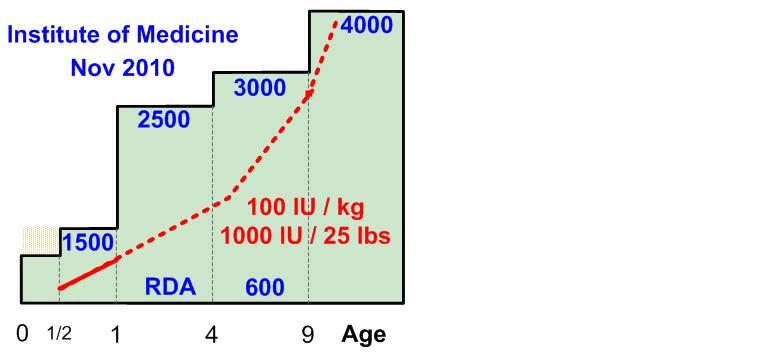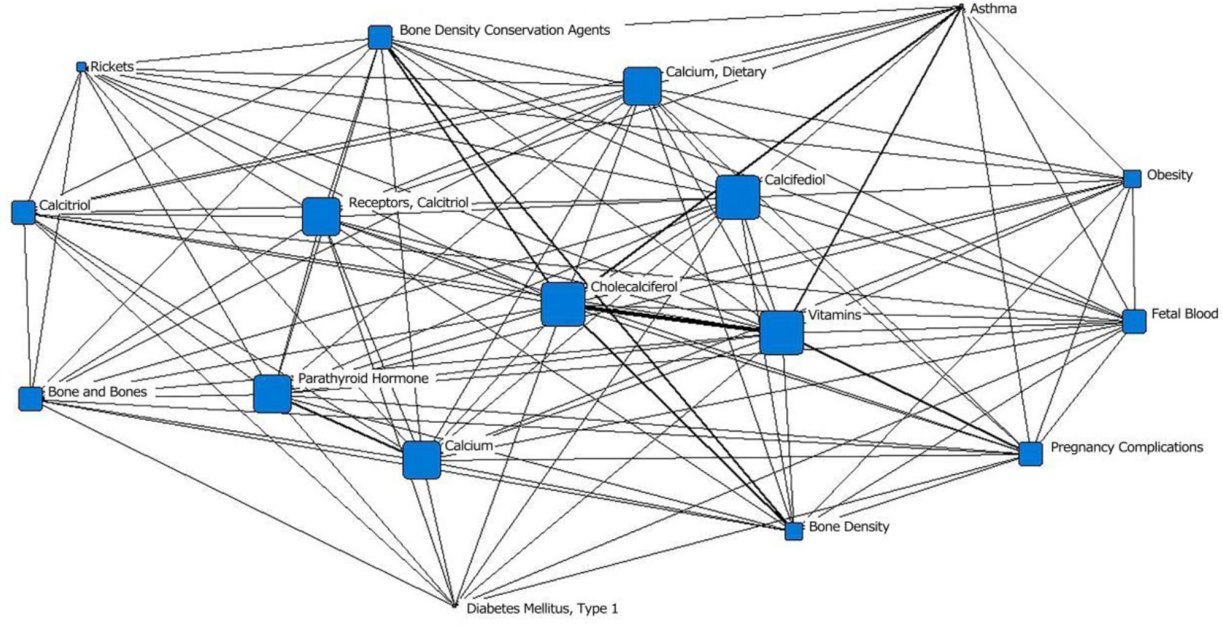Infant-Child
Overview
No consensus on MINIMUM International Units (IU) for healthy infant of normal weight
400 IU Vitamin D is no longer enough
- Was OK in the past century, but D levels have been dropping for a great many reasons.
- FDA doubles the amount of vitamin D permitted in milk – July 2016
No consensus: range is 600 to 1600 IU – based on many randomized controlled trials
Fewer pre-infants were vitamin D deficient when they got 800 IU – RCT Feb 2014
1600 IU was the conclusion of three JAMA studies
- 1000 IU recommended in France and Finland – 2013 - appears to be a good level
Child bone fractures with low vitamin D were 55X more likely to need surgery
Children stayed in ICU 3.5 days longer if low vitamin D – Dec 2015
5 out of 6 children who died in pediatric critical care unit had low vitamin D – May 2014
Preemies should have vitamin D supplements – reaching an agreement – April 2021
Vitamin D loading dose was as effective as daily dosing (rickets in this case) – RCT July 2021
Having a good level of vitamin D cuts in half the amount of:
Asthma, Chronic illness, Doctor visits, Allergies, infection
- Respiratory Tract Infection, Growing pains, Bed wetting
Need even more IUs of vitamin D to get a good level if;
Have little vitamin D: premie, twin, mother did not get much sun access
Get little vitamin D: dark skin, little access to sun
Vitamin D is consumed faster than normal due to sickness
Older (need at least 100 IU/kilogram, far more if obese)
Not get any vitamin D from formula (breast fed) or (fortified) milk
- Note – formula does not even provide 400 IU of vitamin D daily
Infants-Children need Vitamin D
Sun is great – well known for 1,000’s of years.
- US govt (1934) even said infants should be out in the sun
One country recommended 2,000 IU daily for decades – with no known problems
As with adults, infants and children can have loading doses and rarely need tests
Daily dose appears to be best, but monthly seems OK
Vitamin D is typically given to infants in the form of drops
- big difference in taste between brands
- can also use water-soluable form of vitamin D in milk, food, juice,
- Infants have evolved to get a big boost of vitamin D immediately after birth
- Colostrum has 3X more vitamin D than breast milk - provided the mother has any vitamin D to spare
- 100 IU per kg of infant July 2011, Poland etc.

- More than 100 IU/kg is probably better
Did you know that:
Getting Vitamin D into infants
Many infants reject vitamin D drops, even when put on nipple
I speculate that the rejection is due to one or more of: additives, taste, and oils .
Infants have a hard time digesting oils, 1999 1997 and palm oils W.A. Price 1 2 3
Coconut oil, such as in D-Drops, is digested by infants. 1, 2 3
Bio-Tech Pharmacal Vitamin D has NO additves, taste, nor oil
One capsule of 50,000 Bio-Tech Pharmacal Vitamin D could be stirred into monthly formula or given once a month
this would result in ~1,600 IUs per day for infant, and higher dose with weight/age/formula consumption
{include}
Related Searches
items in the category Infant/Child See also
[https://VitaminDWiki.com/Breastfeeding+mother+getting+6400+IU+of+Vitamin+D+is+similar+to+infant+getting+400+IU+%E2%80%93+RCT+Sept+2015#VitaminDWikipagescontainingBREASTFEDorBREASTFEEDINGintitle34asofJan2022_
| 34 pages in VitaminDWiki had BREASTFE*in title as of Jan 2022]
"BIRTH DEFECTS" 172 items as of July 2016
Stunting OR “low birth weight” OR LBW OR preemie OR preemies OR preterm 1940 items as of Oct 2018
153 VitaminDWiki pages contained PRETERM or PREEMIE in title as of Nov 2024
"SUDDEN INFANT DEATH" OR SIDS 214 items as of Dec 2020
Youth category listing has items along with related searches
Rett syndrome associated with low vitamin D, treated by Omega-3
Infant/Child articles
{category}
VitaminDWiki - studies in both categories infant-Child and Intervention
This list is automatically updated
{category}
Search terms for Children and Vitamin D - May 2021
Analysis of Development Trends of the Research Hotspots of Vitamin D in Children
Front. Pediatr., 06 May 2022 | https://doi.org/10.3389/fped.2022.899844
Xuemei Luo, Feifeng Wu, Cheng Wang and Chuan Wen*
Department of Pediatrics, The Second Xiangya Hospital, Central South University, Changsha, China

Objective: Using multivariate statistics and social network analysis techniques, we present a realistic and intuitive visualization of the research hotspots and development trends of vitamin D in children.
Methods: The Medical Subject Headings (MeSH) term “vitamin D” was used to search all the publications (the study subjects were 0–18 years old) included in PubMed by time period. The subject terms for each development stage were extracted, the high-frequency subject terms were extracted using the Bibliographic Items Co-occurrence Matrix Builder (BICOMB), and a core subject term co-occurrence matrix was established. The Netdraw function of Ucinet 6.0 software was used to complete the social network drawing of the core subject term co-occurrence matrix to form a co-word network diagram composed of core subject terms.
Results: Prior to 1979, there were 890 papers with 1,899 core subject terms; from 2010 to 2020, there were 3,773 papers with 12,682 core subject terms. Before 1979, the research direction of vitamin D in children focused on vitamin D in the classical regulation of calcium and phosphorus metabolism. From 1980 to 1989, studies focused on vitamin D metabolites and therapeutic drugs such as “calcitriol” and “calcifediol.” From 1990 to 1999, studies focused on “calcitriol” and its association with “psoriasis,” “chronic renal failure,” and “dermatological drugs.” From 2000 to 2009, studies focused on “vitamin D” and “vitamin D deficiency.” From 2010 to 2020, studies focused on “vitamin D3” and its association with “vitamins,” “bone mineral density protectants,” “asthma,” “obesity,” “pregnancy complications” and “fetal blood.”
Conclusion: Since 2010, the research direction of vitamin D in children has been growing rapidly, and the overall development trend is good. Studies extend from the study of the skeletal effect of vitamin D to the study of its extraskeletal effect and the investigation of mechanisms of its association with related diseases.
📄 Download the PDF from VitaminDWiki
VitaminDWiki - studies in both categories Infant-Child and Virus
This list is automatically updated
{category}
VitaminDWiki associations between Infant-Child and other categories
Pregnancy74; Intervention71; Breathing66; Top news51; Virus42; Diabetes38; Youth35; Deficiency 34; Europe33; Rickets29; Obesity27; Autoimmune27; Omega-324; Loading dose 22; Trauma and surgery21; Skin - Dark20; Meta-analysis19; Bone - Health19; Vitamin D Receptor18; Dental16; Immunity16; Middle East15; Cognitive12; Inflammation12; Cancer11; Intervention - non daily10; Orient10; Rheumatoid Arthritis9; How much9; Liver8; Falls and Fractures8; Fortification 8; Cardiovascular7; Iron7; Toxicity7; Consensus7; Gut7; Antibiotics, probiotics7; Autism6; Vit D Binding Protein6; Sleep6; Noontime sun and D6; Far from equator5; Calcium5; Genetics5; Multiple Sclerosis5; UV 4; Kidney4; Ear4; Depression4; Australia and New Zealand4; Hypertension4; Sports D4;
As of Nov 2022 Click below to see detailed associations
Close Associations
